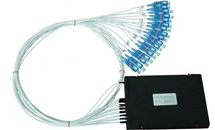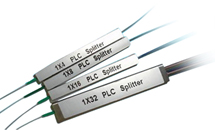PLC Splitters


Click here for the PLC Splitter range
What is a PLC Splitter?
A PLC splitter, or Planar Lightwave Circuit splitter, is a crucial passive optical device used in fiber optic networks. Its primary function is to divide a single optical signal into multiple output signals, allowing for efficient distribution of light across various paths. This technology is based on semiconductor principles and utilizes planar waveguide circuit technology to achieve its splitting capabilities. PLC splitters are essential in applications such as fiber-to-the-home (FTTH) networks, where they facilitate the connection of multiple users to a single fiber line.
The Technology
PLC splitters are designed using advanced semiconductor technology, which allows for precise control over light distribution. The core component of a PLC splitter is the optical PLC chip, which is engineered to manage the splitting of light signals effectively. The design typically includes an optical chip and several optical arrays that are coupled at both ends. Depending on the required output ratio, these arrays can vary, enabling configurations that split signals into 2, 4, 8, 16, 32, 64, or even 128 outputs. This versatility makes PLC splitters suitable for a wide range of applications.
Click here for the PLC Splitter range
Types of PLC Splitters and Their Configurations
PLC splitters come in various configurations to meet different network requirements. Common types include 1x2, 1x4, 1x8, 1x16, 1x32, 1x64, and 1x128 splitters. Each configuration is designed to handle a specific number of output fibers, allowing network designers to choose the appropriate splitter based on the number of connections needed. Additionally, PLC splitters can be customized with different connector types such as SC, LC, and FC, providing flexibility in installation and compatibility with existing systems.
Key Features
One of the standout features of PLC splitters is their low insertion loss and low polarization dependent loss (PDL), which are critical for maintaining signal integrity in optical networks. These devices are designed to operate over a wide wavelength range, typically from 1260 nm to 1620 nm, making them suitable for various applications, including telecommunications and data transmission. Furthermore, PLC splitters can withstand a wide range of operating temperatures, from -40°C to +85°C, ensuring reliability in diverse environmental conditions.
Packaging and Installation Options
PLC splitters are available in several packaging options to accommodate different installation scenarios. Common packaging types include ABS boxes, plug-in modules, LGX trays, and 19-inch rack types. Each packaging solution is designed for ease of installation and maintenance, with many options featuring plug-and-play capabilities that eliminate the need for splicing. For instance, the ABS box type is often used in outdoor fiber distribution applications, while rack-mounted splitters are ideal for data centers and server rooms, providing high-density cabling solutions.
Click here for the PLC Splitter range
Applications of PLC Splitters in Optical Networks
PLC splitters play a vital role in the architecture of optical networks, particularly in passive optical networks (PONs). They are typically installed between the optical line terminal (OLT) and the optical network terminals (ONTs), facilitating the distribution of a single fiber link from the central office to multiple end-users. This capability is essential for delivering high-speed internet and other services in residential and commercial settings. Additionally, PLC splitters are used in various telecommunications applications, including cable television and broadband services.
Advantages
The use of PLC splitters in optical networks offers several advantages. Firstly, they enable efficient signal distribution, allowing multiple users to share a single fiber connection without significant loss of quality. Secondly, their compact design and various packaging options make them easy to integrate into existing infrastructure. Moreover, PLC splitters are cost-effective solutions for expanding network capacity, as they reduce the need for additional fiber lines. Lastly, their reliability and performance in diverse conditions make them a preferred choice for network operators.
Future Trends
As the demand for high-speed internet and advanced telecommunications services continues to grow, the technology behind PLC splitters is also evolving. Future trends may include the development of more compact and efficient designs, enhanced performance metrics, and greater customization options to meet specific network needs. Additionally, advancements in materials and manufacturing processes could lead to even lower insertion losses and improved durability, further solidifying the role of PLC splitters in next-generation optical networks.
Optosun provides a wide range of PLC splitting components based on thin-film filter, planar-waveguide, and fused Biconical tapered technologies.

